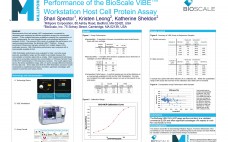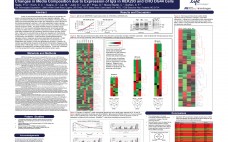The development and regulatory approval of continuous cell lines for manufacturing viral vaccines has brought numerous benefits to production processes. We and others have contributed to upstream advances by improving cell culture media with the development of animal-free and chemically-defined recombinant protein supplements. The supplements developed include recombinant insulin-like growth factor-I (LONG®R3IGF-I), epidermal growth factor (LONG®EGF), transforming growth factor-α (LONG®TGF-α), transferrin (CellPrime™ rTransferrin AF), and albumin (CellPrime ™rAlbumin AF-G or -S). Extensive literature on the action of these bioactive proteins…
Upstream Processing
Performance of the BioScale ViBE Protein Analysis Workstation Host Cell Protein Assay
Measurement of host cell protein (HCP) contaminants is essential for developing and monitoring an effective purification process for recombinant proteins. Of the multiple techniques available to quantify the concentrations of these contaminants, the most popular format uses polyclonal antisera in a sandwich ELISA. The purpose of this work is to evaluate the performance of a newly emerging technology; the BioScale ViBE™ Platform. Using an assortment of bioprocess samples selected from multiple stages of the purification process, ViBE Workstation performance was…
Changes in Media Composition due to Expression of IgG in HEK293 and CHO DG44 Cells
Quality of recombinant/therapeutic proteins produced by engineered cell lines is a concern shared by both manufacturers and regulatory agencies. New assays are needed to facilitate earlier and more rapid analysis of therapeutic protein quality. Cell culture supernatant contains secreted proteins that are indicative of the cellular condition and thus are potential indicators of recombinant protein quality. This study identified changes in secreted host cell proteins (HCP) from cell pools exhibiting varying levels of recombinant antibody expression as determined by quantitative…
Factory of the Future
Fed-batch and perfusion culture are two dominant modes of operation for mammalian-cell-culture based processes. Challenges in the industry (such as competitive products for the same indication or desired cost reductions) are forcing many to explore new production options. Increasingly popular is the application of the ATF™ System to generate ultra high viable cell concentrations (>100m cells/ml) for a “concentrated” or “intensified” process. The use of the ATF System in a typical concentrated fed-batch process is shown which has generated a…
Sartorius Stedim Biotech Filtration Trials with SAFC Ex-Cell Hydrolysate Fusion
SAFC has launched EX-CELL® CD Hydrolysate Fusion, the first fully chemically defined media supplement of its kind in the industry. Sartorius Stedim Biotech and SAFC Biosciences have recently announced a wide-ranging joint cooperation agreement to serve their customers. As a consequence of this effort, a range of 0.2 ÎĽm & 0.1 ÎĽm sterilizing grade filters from different membrane materials were tested for throughput & biological activity post-filtration. This paper provides an insight into superior total throughput performance of the Sartorius…
Working Toward Animal-Free Processing
Biological therapeutics is one of the fastest growing segments of the pharmaceutical industry — so much in fact that the overall cell culture media and supplements market used in bioprocessing applications is reportedly near $800 million (1). An increasingly important trend in cell culture is risk reduction throughout the supply chain, including a stringent focus on key raw materials. Accordingly, the industry has increasingly adopted animal-component-free materials to mitigate concerns over safety, transmissible spongiform encephalopathies, and other contaminations.…
Modeling Bioprocess Cost
At every stage of biopharmaceutical development, efficient and cost-effective protein production is critically important to maintaining the economic viability of both a product and the company developing it. Biopharmaceuticals have significantly evolved through recent protein engineering advances, resulting in highly complex, novel proteins dominating the development pipeline. Such proteins are by definition very difficult to express in a soluble and active form. The success of these products depends on accessing a platform that rapidly produces high-quality, properly folded,…
Mixing in Small-Scale Single-Use Systems
Despite the advantages of presterile, single-use technologies, mixing is one of their most complex applications. Industry has been progressing toward using single-use bag technologies rather than traditional methods of stainless steel tanks and grades A/B processing because of the positive aspects they impart to end users, including a reduced potential for contaminants, cleaning, sterilization, and capital. These technologies offer simplicity and flexibility (1). However, using them for an operation such as mixing can add processing challenges. For example,…
Putting It All into Perspective
As part of The Automation Partnership’s “20 Years of Automated Cell Culture” series, science writer Sue Pearson interviewed Dr. John Birch, the chief scientific officer of biopharmaceuticals for Lonza Custom Manufacturing APIS based in Slough, UK. Birch has been with that company since 1996, Before that, he held senior technical positions at Tate and Lyle, GD Searle, and Celltech. Birch has a PhD in microbiology from London University, where he also spent a period lecturing before moving into…
Demonstrated Performance of a Disposable Bioreactor with an Anchorage-Dependent Cell Line
Increased adoption of disposable storage vessels and mixing systems for biopharmaceutical manufacturing operations has provided economic and efficiency benefits to a number of life-science companies. Single-use technologies have reduced validation requirements, shortened turnaround times, eliminated cleaning regimes, increased the speed of set-up procedures, and facilitated the development of flexible manufacturing platforms. Many biomanufacturers have sought to extend those benefits into the field of cell culture by using disposable bioreactors. Here we describe work undertaken to develop and demonstrate…





